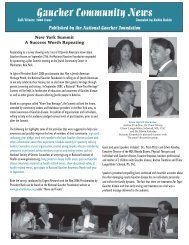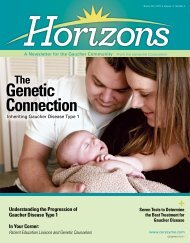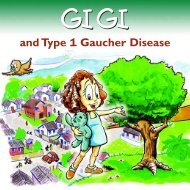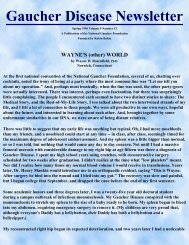Gaucher Community News - National Gaucher Foundation
Gaucher Community News - National Gaucher Foundation
Gaucher Community News - National Gaucher Foundation
- No tags were found...
Create successful ePaper yourself
Turn your PDF publications into a flip-book with our unique Google optimized e-Paper software.
Suzanne has been a registered<br />
physical therapist since 1978. She has<br />
experienced multiple symptoms from<br />
<strong>Gaucher</strong> disease since being diagnosed<br />
in 1981. She is an advocate and speaker<br />
on the subject of exercise and physical<br />
therapy and has written many articles<br />
on its importance for those who are<br />
living with <strong>Gaucher</strong> disease. She can be<br />
reached by calling the NGF or by email<br />
at suzkrup@comcast.net.<br />
Knee limitations after surgery and<br />
teoporosis in spine<br />
By Suzanne Krupskas<br />
1) Q: Six months ago I had a left knee replacement.<br />
In general, the knee is strong and I am painfree. However,<br />
I’m still not able to fully straighten it. When I was<br />
discharged from physical therapy, (which was three months<br />
ago), my therapist told me that I am lacking 15 degrees<br />
of knee extension. My orthopedist says that I may have to<br />
live with this limitation or possibly be manipulated under<br />
anesthesia to break-up the scar tissue. In lieu of undergoing<br />
this procedure are there any exercises I can do at this point<br />
to help get my knee straighter<br />
S.P. from TN<br />
A: Knee limitations are a challenge, especially six months<br />
after surgery. The soft tissue (muscles, tendons, ligaments)<br />
has become extremely tight and possible adhesions<br />
or scar tissue may develop (as your orthopedist indicated).<br />
Before starting any exercise program inform your doctor. I<br />
would suggest pool exercises if you have access to a heated<br />
pool. The warmth of the water would assist in loosening<br />
the soft tissue surrounding the joint. The following pool<br />
exercises would be beneficial: Place your left heel on a<br />
step with the knee straight and your right leg behind.<br />
Bend forward feeling the stretch in the hamstrings (back<br />
of the thigh) and behind the knee. Hold the stretch for 20<br />
seconds. Rest and then repeat for a total of 3 sets. Walk<br />
back and forth in the shallow end accentuating heel to toe<br />
as you’re stepping for 10 laps. Use a noodle to simulate<br />
biking – accentuating knee straightening for 2-3 minutes<br />
I would also suggest the following exercises: hamstring<br />
stretches on land: Sit on a chair and place a foot-stool in<br />
front of you. Place your left foot on the stool with your foot<br />
facing straight up and your right foot down on floor. With<br />
both hands push your thigh down as you lean your body<br />
slightly forward feeling the stretch in the hamstrings and<br />
behind the knee. Stay in that position for 3-4 minutes.<br />
If the stool is too high, place your left leg in front of you<br />
(heel down) on the floor and push your thigh down with<br />
both hands and hold the stretch for 20 seconds for 3 sets.<br />
Step stretch: Place your left heel on a step, knee is straight<br />
as it can be, right leg on the floor. Lean your body<br />
forward slightly and hold the stretch for 20 seconds.<br />
Rest and repeat 3 sets. Just to remind you, by doing these<br />
exercises it does not guarantee full and normal extension.<br />
However, you still would benefit from doing them to assist<br />
in elongating the muscles, tendons and ligaments with the<br />
possibility of gaining more flexibility and more range of<br />
movement.<br />
******<br />
2) Q: I have osteoporosis in my spine. What exercises<br />
would be beneficial for me I sit in front of the computer<br />
most of the day approximately 7-8 hours. I am sedentary<br />
and need guidance on what to do. Thank you. I’m looking<br />
forward to receive your expert advice.<br />
M.T. from VT<br />
A: Osteoporosis is definitely a disease that requires<br />
immediate attention. If you lead a sedentary lifestyle (as<br />
you say you do) the skeletal system is going to be more<br />
compromised and more at risk for further bone resorption<br />
(breakdown). Bone is living tissue that is constantly being<br />
broken down and rebuilt. This balance leads to healthy<br />
bone. However, if there is more breakdown than rebuild<br />
the result is osteoporosis. To prevent further breakdown and<br />
to assist in strengthening the bones, it is medically proven<br />
that bones need loading type of exercises to become denser<br />
such as weight-bearing and weight-resistance exercises.<br />
Although I suggest you start with the following three exercises<br />
4-5 times weekly, it is a necessity for you to discuss these<br />
exercises with your physician. The following routine hones<br />
in on the erector spinae muscle group; this long muscle is<br />
responsible for stabilizing the entire spine. 1) Stand Shoulder<br />
Blade Pinching: Stand with legs shoulder-width apart, knees<br />
slightly bent, stomach tight (tuck your navel towards your<br />
spine), hold onto 3lb. dumbbells in each hand, elbows bent<br />
90 degrees, palms facing each other, with both hands reaching<br />
out in front of you (do not fully straighten elbows), then<br />
pull arms towards chest as you pinch the shoulder blades<br />
together. Hold the contraction for 3 seconds – repeat for 10<br />
times / 3 sets. 2) Modified Standing Military Press: Standing<br />
position as #1, with both hands start at your shoulders,<br />
palms face forward – elbows are bent, push both arms (at<br />
the same time) up above eye level extending your elbows<br />
then return to starting position. Repeat for 10 times / 3<br />
sets. 3) Trunk Extension: Lie on your stomach (either on your<br />
bed but preferably the floor). Place a small pillow under<br />
your pelvis, head down (face is parallel to the floor), arms<br />
by your sides, raise your head (face is still parallel to the<br />
floor) and chest off the bed/floor and hold that position for 3<br />
seconds – repeat for 10 times / 3 sets.<br />
25













